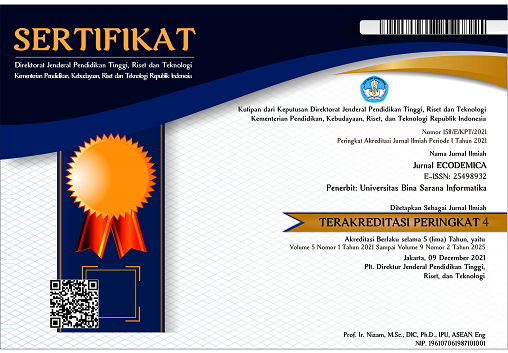Comparative Analysis of the Implementation of HR Accounting on Financial Performance at PT. Bank Syariah Indonesia Tbk
Abstract
Keywords
Full Text:
PDFReferences
Adi, H. R., & Agung, G. (2017). Penerapan Akuntansi Sumber Daya Manusia Terhadap Kinerja Perusahaan. 5(2), 104–119.
Amin, W. T. (2004). Akuntansi Sumber Daya Manusia. Rieneka Cipta offset.
Ariffin, N. (2013). Manajemen Sumberdaya Manudisa:Teori dan Kasus. UNISNU Press.
Bank Syariah Indonesia. (2021). Company Information. https://www.bankbsi.co.id/company-information
Fiscal Yunus, D. (2016). nalisis Simulasi Penerapan Akuntansi Sumber Daya Manusia terhadap Perbandingan Kinerja Keuangan Studi kasusu pada PT Bank Pembangunan Daerah Lampung tahun 2012-2014. Jurnal Akuntansi Dan Keuangan. Universitas Bandar Lampung.
Hamali, A. Y. (2016). Pemahaman Sumber Daya Manusia. Center for Academic Publishing Service.
Ikatan Akuntan Indonesia. (2010). PSAK No. 19 Tentang Aset Tidak Berwujud (Dewan Standar Akuntansi Keuangan (ed.); Revisi). PT. Raja Grafindo.
Isnaniati, S. (2020). PENGARUH PENGUNGKAPAN AKUNTANSI SUMBER DAYA MANUSIA DALAM LAPORAN KEUANGAN TERHADAP KINERJA KEUANGAN PERUSAHAAN (Studi Kasus Pada PG. Modjopanggoong Tulungagung). Juripol (Jurnal Institusi Politeknik Ganesha Medan), 3(2), 73–78. https://doi.org/10.33395/juripol.v3i2.246
Rahayu, A. W. W., & Affandy, D. P. (2012). Analisis Penerapan Akuntansi Sumber Daya Manusia terhadap Perbandingan Kinerja Laporan Keuangan pada PT. BPRS Mitra Harmoni Malang. Jurnal Ilmiah Mahasiswa FEB. https://jimfeb.ub.ac.id/index.php/jimfeb/article/view/258
Riyanto, B. (1990). Dasar-dasar Pembelanjaan Perusahaan (4th ed.). Yayasan Badan Penerbit Gadjah mada.
Tandige, J., & Sinurat, R. (2020). PENERAPAN SISTEM AKUNTANSI SUMBER DAYA MANUSIA TERHADAP KINERJA KARYAWAN PADA BENGKEL PAPUA MOTOR JAYA DI KOTA SORONG. XIV, 46–53.
DOI: https://doi.org/10.31294/eco.v7i1.15162
Copyright (c) 2023 Listya Devi Junaidi, Sri Mulyani

This work is licensed under a Creative Commons Attribution-ShareAlike 4.0 International License.
ISSN: 2355-0295 || EISSN: 2549-8932
-----------------------
Indexed by:
dipublikasikan oleh LPPM Universitas Bina Sarana Informatika dengan dukungan Relawan Jurnal Indonesia
Jl. Kramat Raya No.98, Kwitang, Kec. Senen, Kota Jakarta Pusat, DKI Jakarta 10450

This work is licensed under a Creative Commons Attribution-ShareAlike 4.0 International License







